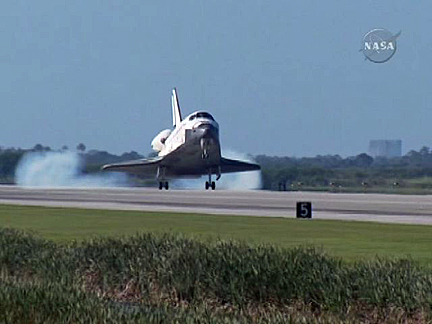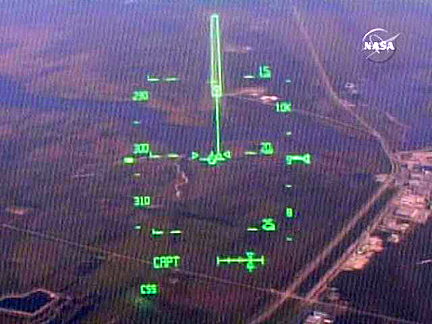Shuttle Atlantis returns to Earth
The shuttle Atlantis closed out its 32nd and final planned mission with a smooth Florida landing Wednesday, wrapping up a quarter century of service with a successful space station assembly mission.
Approaching from the south, commander Kenneth Ham took over manual control at an altitude of 50,000 feet above the spaceport and guided Atlantis through a 320-degree right turn to line up on runway 33.

Diving at a steep 21-degree angle, Ham pulled the nose up, pilot Dominic "Tony" Antonelli deployed the main landing gear and Atlantis settled to a tire-smoking, on-time touchdown at 8:48:11 a.m. EDT.
"And Houston, Atlantis, we have wheels stopped," Ham radioed after Atlantis rolled to a stop.
"Hock, that landing was something that your Air Force crewmates should have really been proud of, that looked pretty sweet," astronaut Charles Hobaugh, a Marine, joked from mission control.
"For you and your crew, that was a suiting end to an incredible mission," he said. "I'm sure the station crew members hated to see you leave, but we're glad to have you back. You guys executed flawlessly and not only that, you had a great time doing it. That was very evident from the ground. Everybody down here really enjoyed working with you."

Mission duration was 11 days, 18 hours, 28 minutes and two seconds for a voyage spanning 186 complete orbits and 4.9 million miles since blastoff May 14 from nearby pad 39A.
Ham, Antonelli, flight engineer Michael Good, Stephen Bowen, Piers Sellers and Garrett Reisman joined NASA managers and engineers on the runway for a traditional walk-around inspection before heading back to crew quarters for reunions with friends and family members. All six were scheduled to fly back to Houston Thursday.
"It's a shame," Antonelli said later. "From the condition we brought her back in, she is so ready to get stacked and back out to the launch pad. You can tell that's where she wants to be."
Touchdown marked a bittersweet moment for scores of engineers and technicians awaiting Atlantis' return. With only two flights remaining on NASA's manifest, every flight now means a final voyage for one of the agency's three space shuttles.

Discovery is up next, scheduled for launch in September or October, followed by Endeavour late this year or early next on what is currently planned as the shuttle program's final mission.
While Atlantis is not scheduled to fly again, it will be processed for launch on a possible rescue mission if Endeavour experiences a major problem that might prevent a safe re-entry.
NASA managers are holding out hope the Obama administration will approve a final flight for Atlantis to take advantage of an external tank and booster set that otherwise would go to waste.
By launching with a reduced crew of four, a rescue flight would not be needed because the astronauts could seek safe haven aboard the space station and use Russian Soyuz capsules for eventual return to Earth.
A few hours after Atlantis landed, Sen. Bill Nelson, a Florida Democrat, released a letter to President Obama "to inform you of my intention to include language authorizing an additional space shuttle flight" in the fiscal 2011 budget.
"The new mission, STS-135, would be flown with a minimum crew of four astronauts and would provide critical spare parts and logistics for long-term ISS operations," Nelson wrote. "The mission would be planned for the summer of 2011 and would mark the last flight of the space shuttle program."
Along with helping resupply the space station, an additional flight by Atlantis "will allow us to more smoothly transition the workforce in Florida and Texas from the space shuttle program to the vision you've set for NASA's future," Nelson wrote. "It will also guarantee U.S. access to space for a longer period of time, and thereby help to close the spaceflight gap until a new domestic capability is provided.
"Last but not least, it will reduce risk to the station should a major component fail and need to be replaced before STS-135 is flown."
First launched in October 1985, Atlantis flew five military missions, made seven flights to the Russian Mir space station and 11 to the International Space Station. It launched two planetary probes - Magellan to Venus and Galileo to Jupiter - deployed the Compton Gamma Ray Observatory and visited the Hubble Space Telescope for a final overhaul last year.
"It's a real honor to be among the 191 crew members that have flown on Atlantis in her over 300 days in orbit, 120 million miles," Bowen said. "Atlantis is actually named after a ship of research and discovery from a place I happened to study, Woods Hole Oceanographic Institute. And she has definitely lived up to her name."
Said Sellers: "I hope that when she lands successfully, that she goes somewhere and gets the respect she deserves as a ship of exploration. People like to visit ships like the Constellation, the Constitution, see where they've been and what they've done. And Atlantis is one of that line."
During a week of docked operations at the International Space Station, the astronauts installed a new Russian module and carried out three spacewalks to install a backup Ku-band antenna, a robot arm equipment mounting platform and six new solar array batteries.
They also delivered some three tons of supplies and 1,300 pounds of fresh water generated by the shuttle's fuel cells.
With Atlantis back on the ground, the space station crew is gearing up for the upcoming departure of Expedition 23 commander Oleg Kotov, NASA flight engineer Timothy Creamer and Japanese astronaut Soichi Noguchi, who are wrapping up six months in space.
Kotov, Creamer and Noguchi are scheduled to land in Kazakhstan aboard the Soyuz TMA-17 spacecraft around 11:27 a.m. EDT on June 1. They will be replaced aboard the station by Douglas Wheelock, Shannon Walker and cosmonaut Fyodor Yurchikhin, scheduled for launch aboard the Soyuz TMA-19 spacecraft around 5:35 p.m. on June 15.
Approaching from the south, commander Kenneth Ham took over manual control at an altitude of 50,000 feet above the spaceport and guided Atlantis through a 320-degree right turn to line up on runway 33.

The shuttle Atlantis, seconds away from touchdown on
runway 33. (Credit: NASA TV)
Diving at a steep 21-degree angle, Ham pulled the nose up, pilot Dominic "Tony" Antonelli deployed the main landing gear and Atlantis settled to a tire-smoking, on-time touchdown at 8:48:11 a.m. EDT.
"And Houston, Atlantis, we have wheels stopped," Ham radioed after Atlantis rolled to a stop.
"Hock, that landing was something that your Air Force crewmates should have really been proud of, that looked pretty sweet," astronaut Charles Hobaugh, a Marine, joked from mission control.
"For you and your crew, that was a suiting end to an incredible mission," he said. "I'm sure the station crew members hated to see you leave, but we're glad to have you back. You guys executed flawlessly and not only that, you had a great time doing it. That was very evident from the ground. Everybody down here really enjoyed working with you."

Atlantis touches down to end its final planned mission.
(Credit: NASA TV)
Mission duration was 11 days, 18 hours, 28 minutes and two seconds for a voyage spanning 186 complete orbits and 4.9 million miles since blastoff May 14 from nearby pad 39A.
Ham, Antonelli, flight engineer Michael Good, Stephen Bowen, Piers Sellers and Garrett Reisman joined NASA managers and engineers on the runway for a traditional walk-around inspection before heading back to crew quarters for reunions with friends and family members. All six were scheduled to fly back to Houston Thursday.
"It's a shame," Antonelli said later. "From the condition we brought her back in, she is so ready to get stacked and back out to the launch pad. You can tell that's where she wants to be."
Touchdown marked a bittersweet moment for scores of engineers and technicians awaiting Atlantis' return. With only two flights remaining on NASA's manifest, every flight now means a final voyage for one of the agency's three space shuttles.

The view through pilot Dominic Antonelli's heads-up display
as Atlantis lined up on runway 33. (Credit: NASA TV)
Discovery is up next, scheduled for launch in September or October, followed by Endeavour late this year or early next on what is currently planned as the shuttle program's final mission.
While Atlantis is not scheduled to fly again, it will be processed for launch on a possible rescue mission if Endeavour experiences a major problem that might prevent a safe re-entry.
NASA managers are holding out hope the Obama administration will approve a final flight for Atlantis to take advantage of an external tank and booster set that otherwise would go to waste.
By launching with a reduced crew of four, a rescue flight would not be needed because the astronauts could seek safe haven aboard the space station and use Russian Soyuz capsules for eventual return to Earth.
A few hours after Atlantis landed, Sen. Bill Nelson, a Florida Democrat, released a letter to President Obama "to inform you of my intention to include language authorizing an additional space shuttle flight" in the fiscal 2011 budget.
"The new mission, STS-135, would be flown with a minimum crew of four astronauts and would provide critical spare parts and logistics for long-term ISS operations," Nelson wrote. "The mission would be planned for the summer of 2011 and would mark the last flight of the space shuttle program."
Along with helping resupply the space station, an additional flight by Atlantis "will allow us to more smoothly transition the workforce in Florida and Texas from the space shuttle program to the vision you've set for NASA's future," Nelson wrote. "It will also guarantee U.S. access to space for a longer period of time, and thereby help to close the spaceflight gap until a new domestic capability is provided.
"Last but not least, it will reduce risk to the station should a major component fail and need to be replaced before STS-135 is flown."
First launched in October 1985, Atlantis flew five military missions, made seven flights to the Russian Mir space station and 11 to the International Space Station. It launched two planetary probes - Magellan to Venus and Galileo to Jupiter - deployed the Compton Gamma Ray Observatory and visited the Hubble Space Telescope for a final overhaul last year.
"It's a real honor to be among the 191 crew members that have flown on Atlantis in her over 300 days in orbit, 120 million miles," Bowen said. "Atlantis is actually named after a ship of research and discovery from a place I happened to study, Woods Hole Oceanographic Institute. And she has definitely lived up to her name."
Said Sellers: "I hope that when she lands successfully, that she goes somewhere and gets the respect she deserves as a ship of exploration. People like to visit ships like the Constellation, the Constitution, see where they've been and what they've done. And Atlantis is one of that line."
During a week of docked operations at the International Space Station, the astronauts installed a new Russian module and carried out three spacewalks to install a backup Ku-band antenna, a robot arm equipment mounting platform and six new solar array batteries.
They also delivered some three tons of supplies and 1,300 pounds of fresh water generated by the shuttle's fuel cells.
With Atlantis back on the ground, the space station crew is gearing up for the upcoming departure of Expedition 23 commander Oleg Kotov, NASA flight engineer Timothy Creamer and Japanese astronaut Soichi Noguchi, who are wrapping up six months in space.
Kotov, Creamer and Noguchi are scheduled to land in Kazakhstan aboard the Soyuz TMA-17 spacecraft around 11:27 a.m. EDT on June 1. They will be replaced aboard the station by Douglas Wheelock, Shannon Walker and cosmonaut Fyodor Yurchikhin, scheduled for launch aboard the Soyuz TMA-19 spacecraft around 5:35 p.m. on June 15.